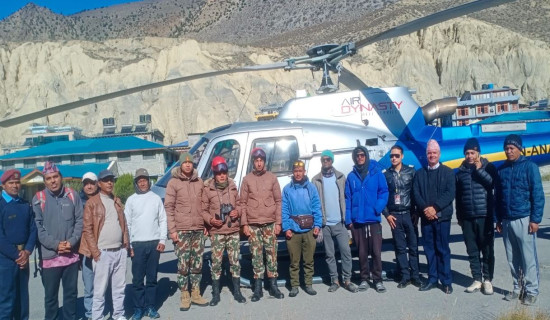- Thursday, 13 November 2025
Identify Wartime Explosives
A few days ago, a team of the Nepali Army was reported to have disposed of a hand grenade found in Madi Municipality-6 of Sankhuwasabha district. The destructive matter is suspected to have been hidden underground during the time of the Maoist insurgency. Similarly, it is a month-old story that two children died and two others got injured seriously in Panchthar district after an explosive stuff went off suddenly when they were playing outside their home. All of them were from the same family. Those maimed in the explosion are still undergoing medical treatment. These frequent incidents highlight the need to focus on a graver issue: disposal of wartime weapons.
The decade-long Maoist insurgency came to an end with the signing of the Comprehensive Peace Accord (CPA) in November 2006. It is a matter of serious concern that the conflict-era arms have still continued taking their toll on human lives even after 18 long years since the start of the peace process. Any kind of conflict or war requires a clear closure and this is possible through a transitional justice process. It is helpful to ensure the society moves forward and prevent conflicts from arising. Countries like Rwanda went through serious genocides and the nation focused on transitional justice in the post-war scenario. And similar efforts have been made in other conflict-affected regions as well.
What is more appalling is that neither the responsible political parties nor civil society members seem to have taken this issue seriously. While the major political parties have stood united when it comes to concluding the lingering process of delivering transitional justice to the conflict victims, they must discuss the issue of managing the wartime explosives. Only recently, the federal parliament endorsed an amended bill on transitional justice. Now amidst these developments, the emerging issue of explosives should also be addressed in a timely manner. The government now needs to mobilise its relevant mechanisms to deal with this grave problem. It must ensure that nobody will suffer from this problem again.
A former Nepali Army officer has highlighted that the explosives from the war, depending on how they have been kept hidden, have the potential to remain active even for 50 years. There might be many remote areas around the country where explosives and dangerous weapons have been placed hidden. So, this is really a serious matter to ponder over. The Nepali Army had made efforts to collect the wartime weapons. But their record at the time did not include many weapons that had been hidden in jungles, lands and homes. So, this lack of information has the potential to cause more harm. It is harmful for the children who are totally unaware about its danger.
It is high time that the Nepali Army, police, former combatants and local communities come together to identify the locations where explosives have been kept. The government has decided to provide some financial assistance for the treatment of the injured children in Panchthar. But rather than coming up with curative measures, our focus must be on preventive measures.
The remnants of the war have continued to affect society even today. Transitional justice will only be possible when such remnants are totally removed. Hopefully, the commissions formed for the transitional justice process will be mobilised to tackle this issue. If we want to go on the path of transitional justice, it should not be done in a half-hearted way. The government must ensure the protection of human rights and prevent any more casualties from happening. Other concerned stakeholders should also be proactive in this matter.









-original-thumb.jpg)







